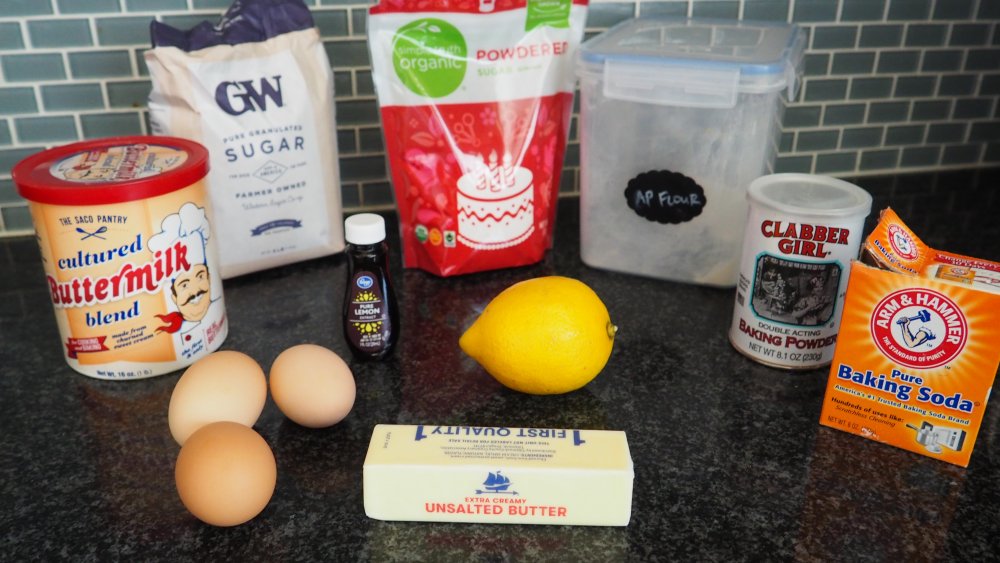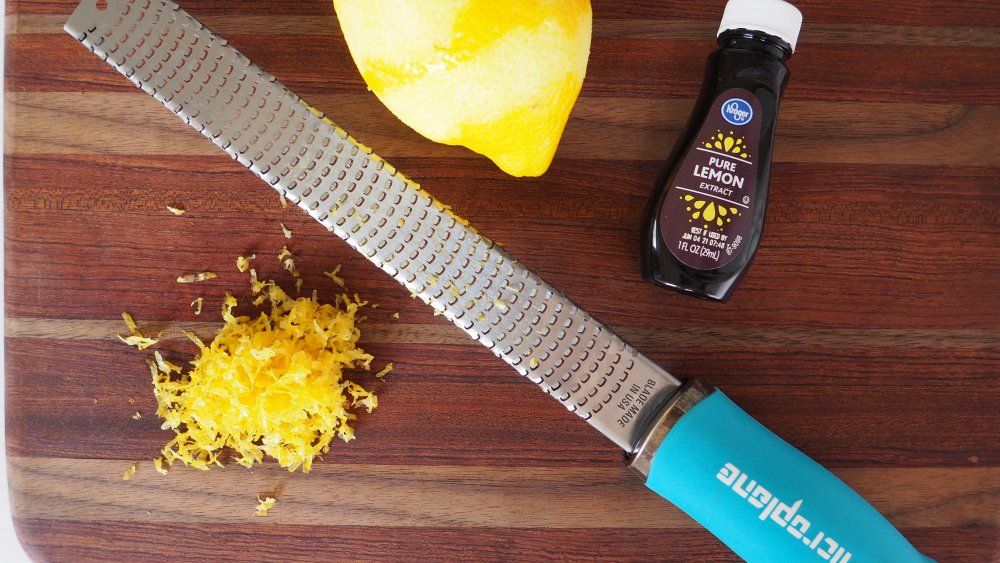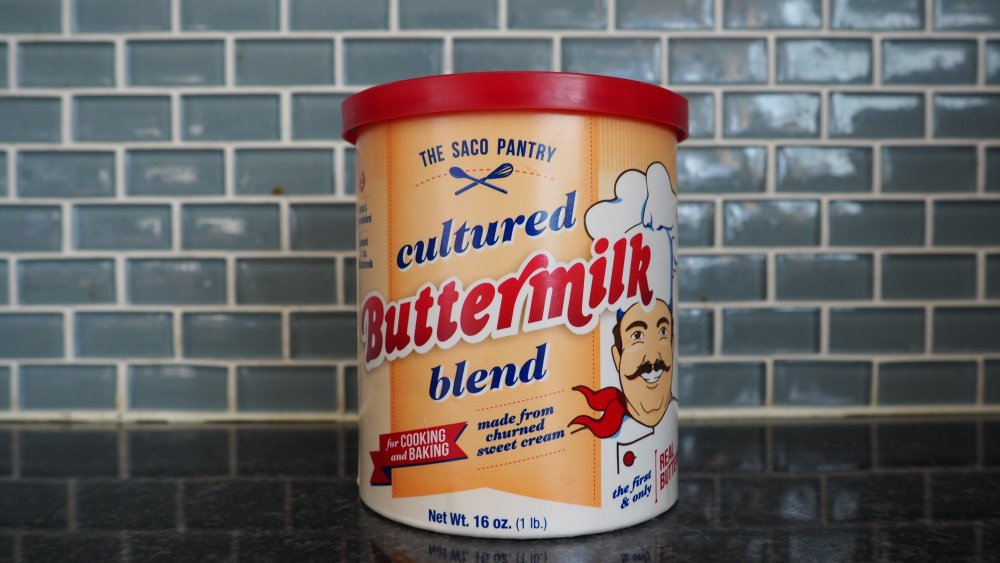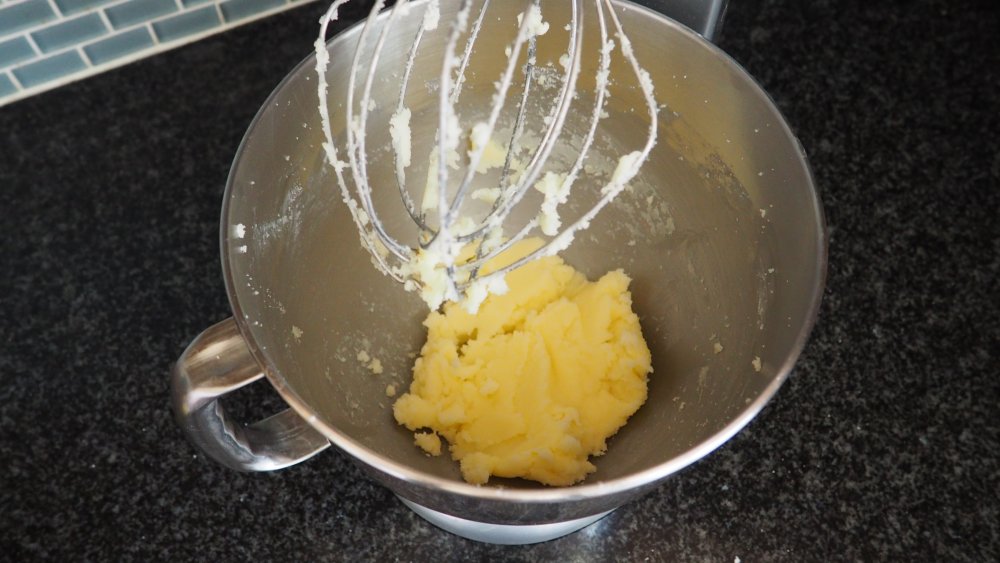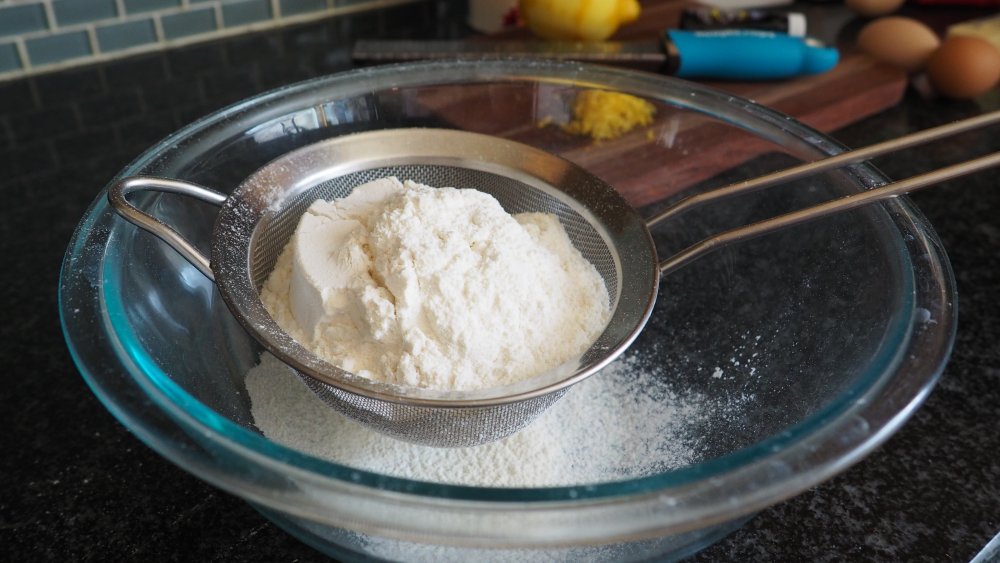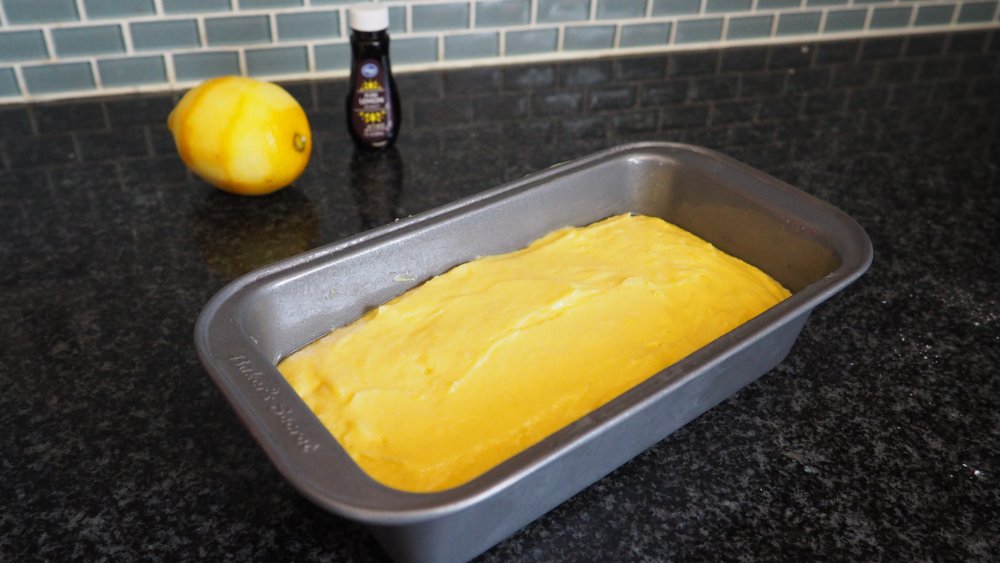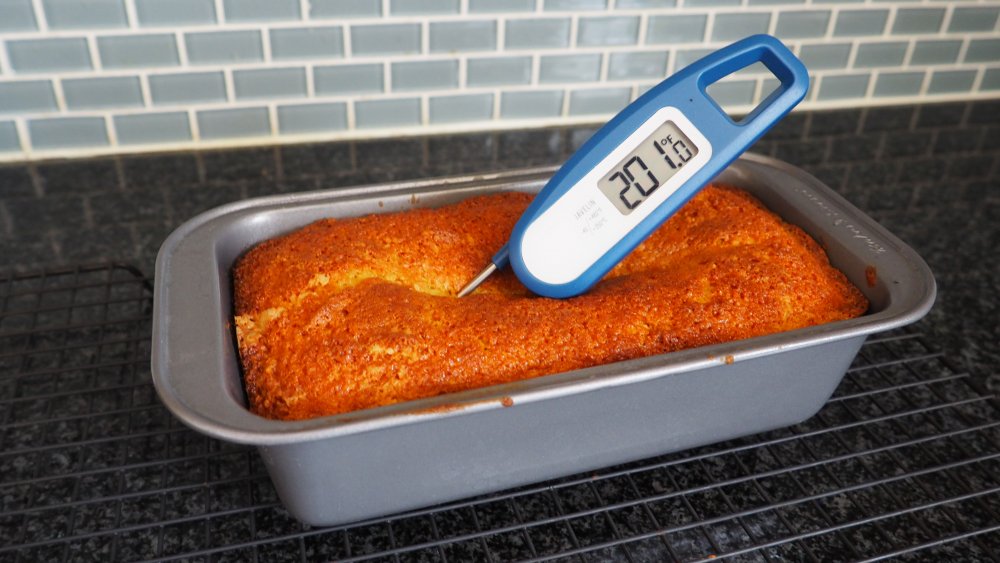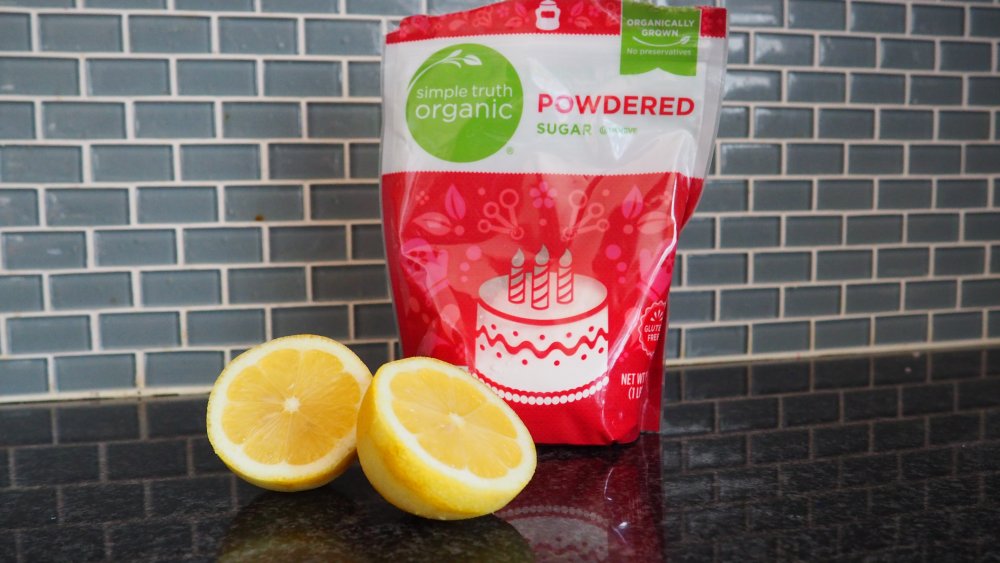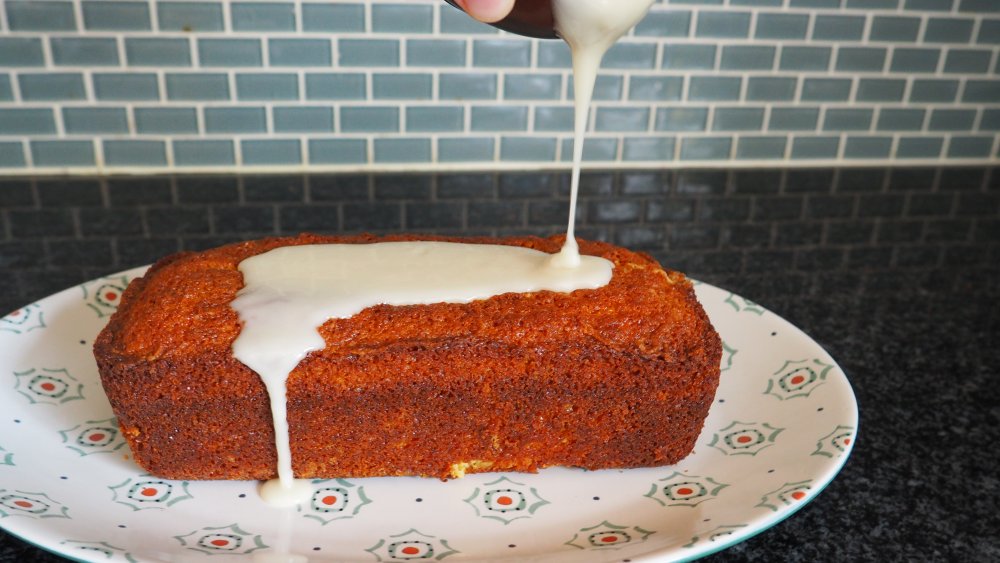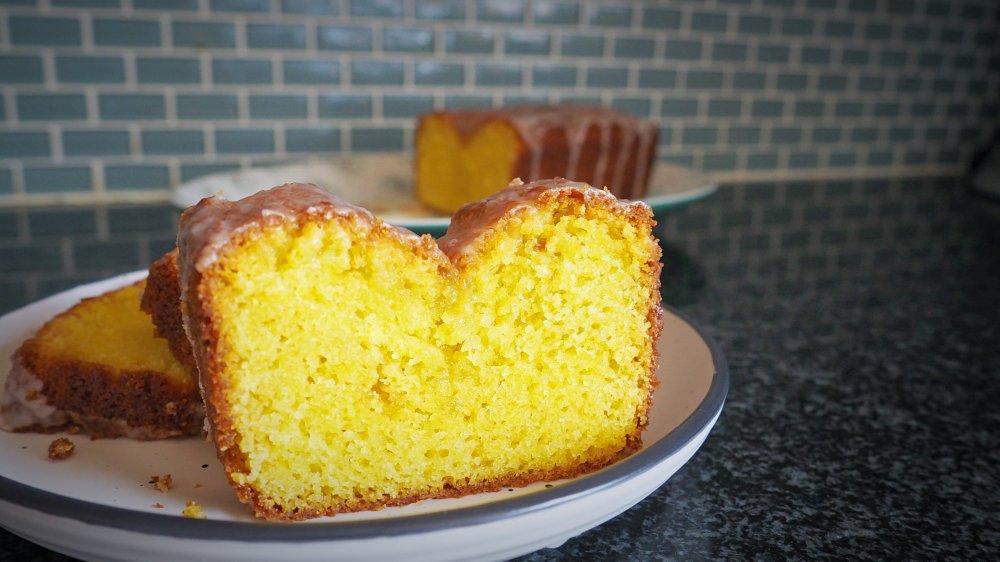Copycat Starbucks Lemon Loaf Recipe
Starbucks might have started out as a coffee chain, but we've fallen in love with their food offerings. From savory egg wraps and sausage biscuits for breakfast to protein boxes and warm sandwiches for lunch, we find ourselves skipping other drive-thrus for the Starbucks experience instead. It's not just their savory offerings, either. When we're in the mood for a sweet treat, they have plenty of options, but we always find ourselves gravitating towards that tangy iced lemon loaf cake. It's buttery and sweet with a super bright lemony flavor that keeps us digging back in for bite after bite.
The more we have it, the more we want! But it's kind of embarrassing to order three slices of their lemon loaf, especially when the employees know you've been working there solo all day. So we decided to figure out how to make this tasty treat at home. Did we get anywhere close to replicating the flavor of the original? Read on to find out!
Gather the ingredients for copycat Starbucks lemon loaf
There are a lot of copycat Starbucks lemon loaf recipes out there, but we wanted ours to be as close to the original as possible. So we took a peek at the list of ingredients on Starbucks' website. We skipped the preservatives and binders like guar gum, xanthan gum, beta carotene, and soy lecithin and focused on the main ingredients in the iced loaf.
We weren't surprised to see flour, sugar, eggs, buttermilk, baking powder, baking soda, and salt on the list. And we had guessed the icing was made from lemon juice and powdered sugar, two ingredients we found on the list. The one ingredient we weren't 100 percent certain on was the "lemon flavedo," which says it contains lemon peel, sugar, and lemon oil. We found the product online — a sugar-infused lemon peel — but it's only available in 50-pound tubs. Instead, we decided to use a combination of lemon extract, which is sold at most grocery stores, and freshly zested lemon peel.
You'll find a full list of the ingredients, including the quantities and step-by-step baking instructions, at the end of this article.
How does the copycat Starbucks lemon loaf get its incredible lemon flavor?
The thing that makes Starbucks lemon loaf so craveable is its bright lemon flavor. It's sweet — but not too sweet — and the icing has a lightly tangy flavor to balance out the sugar. But if you taste the loaf by itself without any of the icing, you'll notice that the cake isn't tangy at all. It's packed full of lemon flavor, but without any of the associated sourness. How do they achieve it? It's all about the zest.
According to What's Cooking America, the difference between lemon juice and zest has to do with how the aromatic compounds are suspended. With lemon juice, the compounds are suspended in water, which will evaporate when exposed to the heat of the oven. Since the acidic components don't evaporate, you would be left with a very tart cake if you put lemon juice into the batter. The aromatic compounds in the lemon peel, on the other hand, are suspended in oil, which doesn't evaporate. Using lemon zest and lemon extract (made from lemon oil) will leave you with a powerful lemon flavor without any of the associated sourness.
What makes the copycat Starbucks lemon loaf tender?
The best part about Starbucks lemon loaf — other than its incredible flavor — is its consistency. It's moist and tender, but it holds together without falling apart as you eat it. This isn't an easy task, but it comes down to two things: Choosing the right ingredients and mixing them together in the correct order. We'll talk more about how to achieve the latter in a minute, but we want to talk about an ingredient that can help your copycat Starbucks lemon loaf turn out perfect: Dairy.
Fine Cooking explains that the addition of dairy like sour cream, buttermilk, or cream cheese keeps the cake moist as it bakes. When you use a dairy product that also contains acidic ingredients (like buttermilk), the acid in buttermilk tenderizes the gluten found in the flour to create a finer crumb. Put it all together, and you'll end up with a perfect pound cake.
A lot of online copycat recipes use sour cream or yogurt instead of buttermilk. Since we found buttermilk on the list of ingredients on Starbucks' website, we used it to stay authentic. We love using shelf-stable powdered buttermilk, too, because it doesn't force you to figure out how to use up all the leftovers.
Cream the butter and sugar together for the best copycat Starbucks lemon loaf
Before we get started, we'll want to preheat the oven to 350 degrees Fahrenheit and prepare a loaf pan by greasing it with butter and dusting it with a thin layer of flour. From there, a perfect pound cake is made by mixing all the ingredients in a specific order. You could certainly dump everything into the mixer at once if your patience is running thin, but your cake will turn out dense and dry instead of light and dry. Instead, measure the ingredients in advance and get ready to add them in layers.
It all starts with creaming butter and sugar together, and you'll need to have very soft butter — soft enough that it can easily bend when you pick it up. So, you'll want to plan ahead and pull the butter out of the refrigerator about an hour before you want to bake. From there, place the softened butter in the bowl of the stand mixer along with the sugar. Using a whisk attachment, cream the butter and sugar for three full minutes. This process aerates the butter, filling it with bubbles. When the cake goes into the oven, the gasses released by the baking powder and sugar will capture those air bubbles, creating a light texture and a fine crumb.
Sifted flour creates the perfect copycat Starbucks lemon loaf
After the butter is light and airy, we'll add the remaining ingredients in a few stages. We start by adding the eggs one at a time, letting each egg fully incorporate before adding the next egg. This creates a thick emulsion, incorporating the eggs into the fat molecules of the butter to protect those air bubbles we created in the previous step. From there, we'll add the dry and liquid ingredients in alternating steps, so you want the flour to be as light as possible.
Sifting the flour using a flour sifter or a fine-mesh strainer is the best way to break up the lumps of the flour, preventing clumps of dry flour in the batter. When it comes to baking something delicate like pound cake, you don't want to overmix the flour and overdevelop the gluten, toughening up the batter like bread dough. Instead, the sifted flour is light and will incorporate easily into the batter. We'll also mix the baking powder, baking soda, and salt in with the salt, using a whisk to make sure we don't create any clumps in the already sifted flour.
Mix in the remaining ingredients for copycat Starbucks lemon loaf
From here, the batter is almost complete. Add the lemon extract and lemon zest to the butter-egg mixture and turn the mixer to a low speed. Working in batches, add half the flour to the mixture. When the flour is incorporated, add half the buttermilk and mix until the batter looks nice and smooth. If needed, stop the mixer and scrape down the bowl using a silicone spatula to free any unmixed ingredients from the side of the bowl. Then, repeat the process, adding the remaining half of the flour before adding the last half of the buttermilk.
Mixing in stages like this ensures that the buttermilk will combine into the batter. You see, this lemon loaf recipe contains more butter than liquid, and oil and water don't normally like to mix. By incorporating a small amount of flour into the butter mixture, we'll allow the buttermilk to slowly bond to the gluten molecules and better incorporate into the batter.
When it's all mixed together, pour the batter into a loaf pan and bake your copycat Starbucks lemon loaf for 45 minutes to an hour.
How do you know when the copycat Starbucks lemon loaf is finished baking?
Every oven is different, so it's difficult to give a hard-and-fast rule for when your lemon loaf will finish baking. Instead, we'll set a timer for 45 minutes and pay attention to the signs to see if the loaf is cooked all the way through. According to King Arthur Flour, there are several ways to know when a cake is finished baking. First, look to see if the edges have shrunk away from the sides of the loaf pan. Then, look at the top of the cake. If it's golden brown with a firm but springy top, the lemon loaf is close to being finished.
Then, you'll want to check the inside of the cake. You can insert a toothpick or a paring knife into the center of the loaf. If it comes out clean, the crumb is set and the middle of the loaf is also finished baking. For extra assurances, you can check the internal temperature with an instant-read thermometer. When it's between 200 and 210 degrees Fahrenheit, the cake is likely finished.
If the top is browned to your liking but the inside still needs time, feel free to tent a piece of aluminum foil over the top before you continue baking.
Whip up the icing for copycat Starbucks lemon loaf
While the cake is baking, it's time to whip up the icing for our copycat Starbucks lemon loaf. The icing is exceedingly simple — just lemon juice, powdered sugar, and a pinch of salt. The citrus juice provides lemon flavor with a punch of tanginess while the sugar sweetens things up while also creating the body for the icing. The salt might seem like an odd addition, but it brings out the other ingredient's natural flavors. Feel free to play around with the ratio here, adding a splash of water or extra lemon juice if the mixture is too thick. You can also add additional flavoring ingredients, like vanilla extract.
If you don't have powdered sugar on hand, you can make some with regular sugar. Blend the sugar using a food processor or a spice grinder until it's a fine powder. Add a tablespoon of cornstarch for every cup of sugar and pulse to combine the two powders.
Let the copycat Starbucks lemon loaf cool completely before icing it
When the lemon loaf comes out of the oven, it's going to smell absolutely amazing. You'll be tempted to ice it right away and scarf down a slice (or two!). Not so fast; you need to let the loaf cool all the way down before icing and slicing it. When it comes out of the oven, let the loaf pan cool for about five minutes. Then, use a butter knife to release the loaf from the pan. If you greased and floured the pan in the first step, it should come out pretty easily.
Then, let the loaf sit on a cooling rack until it's completely cool to the touch. Trying to ice it earlier is not recommended, as the icing will melt and slip off the loaf instead of sitting beautifully on the top. When you're ready, simply pour the icing on top and smooth it out using a spatula. Slice the loaf into eight to ten slices and enjoy.
The best way to store this loaf is in an airtight container on the counter. You don't want to refrigerate it, which will dry out the cake, but it should be safe to eat for four to five days. If you happen to end up with leftovers, wrap the slices in plastic wrap, cover them in aluminum foil, and freeze them for up to six months.
How close did we get to the original Starbucks lemon loaf?
When it comes to flavor and texture, we absolutely nailed it with this recipe. Our copycat Starbucks lemon loaf turned out perfectly tender and moist, with a tight crumb that held together beautifully without feeling dense. The loaf itself was sweet with a bright lemon flavor, and the tangy frosting was so good, we licked the extra off the plate.
Where they definitely beat us out is in the presentation department. Our icing — while 100 percent delicious — is nowhere near as thick as theirs. Perhaps the addition of those emulsifiers and binders like guar gum and xanthan gum helped their frosting bind together more efficiently. But, ours tasted great, so we won't beat ourselves up too much.
As a bonus, when we put our ingredients into a nutrition calculator, our lemon loaf is much healthier than Starbucks' — theirs has 470 calories per serving, and ours has 258 to 322, depending on whether you slice it into eight or ten slices. We'll definitely say yes to a guilt-free version of our favorite breakfast treat!
Copycat Starbucks lemon loaf directions
Starbucks' lemon loaf is buttery and sweet with a super bright lemony flavor that keeps us digging back in for bite after bite.
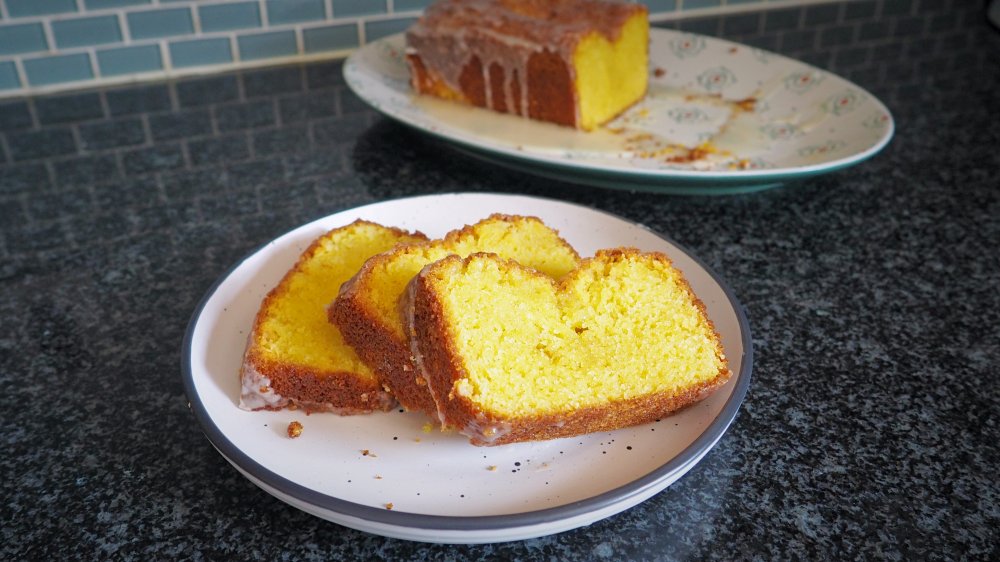
Ingredients
- 1-1/2 cups all-purpose flour
- 1/2 teaspoon baking powder
- 1/4 teaspoon baking soda
- 1/4 teaspoon plus pinch salt
- 1/2 cup unsalted butter, softened at room temperature for about an hour
- 1 cup granulated sugar
- 3 large eggs, room temperature
- 1 tablespoon lemon extract
- zest of 1 large lemon
- 1/3 cup buttermilk
- 1 cup powdered sugar
- 1 tablespoon lemon juice
- Pinch kosher salt
Directions
- Preheat the oven to 350 degrees Fahrenheit.
- Grease an 8 x 4-inch loaf pan well with butter or vegetable shortening. Dust a layer of flour over the top of the butter, pour out the excess flour, and set aside.
- Sift the flour into a medium-sized bowl. Whisk in the baking powder, baking soda, and salt. Set aside.
- Place the softened butter and sugar in the bowl of a stand mixer. Using the whisk attachment, cream the mixture until it's light and fluffy, about 3 minutes at medium speed.
- With the mixer running, add the eggs one at a time, waiting until each egg is incorporated to add the next egg. When all the eggs are incorporated, add the lemon extract and lemon zest.
- Turn the mixer to low speed and add half of the flour mixture. When the flour is incorporated, add half of the buttermilk. If needed, stop the mixer and scrape down the bowl using a silicone spatula to free any unmixed ingredients from the side of the bowl.
- Repeat the process with the remaining half of the flour and buttermilk.
- Pour the batter into the prepared pan and bake for 45 to 60 minutes, until a toothpick inserted in the center comes out clean and the top feels firm. You can also check the internal temperature, which should range between 200 to 210 degrees Fahrenheit. If the cake isn't finished but the top is browned to your liking, tent a piece of aluminum foil over the top and continue baking.
- Let the loaf cool for 5 minutes in the pan. Then, loosen the edges using a butter knife and turn the loaf out onto a cooling rack. Let the loaf cool fully before icing.
- While the lemon loaf is cooling, whisk together the powdered sugar, lemon juice, and pinch of salt, adding extra juice or sugar if needed to create a thick icing.
- Drizzle the icing over top of the cooled loaf and slice.
Nutrition
| Calories per Serving | 377 |
| Total Fat | 13.6 g |
| Saturated Fat | 8.0 g |
| Trans Fat | 0.5 g |
| Cholesterol | 100.7 mg |
| Total Carbohydrates | 59.7 g |
| Dietary Fiber | 0.9 g |
| Total Sugars | 40.6 g |
| Sodium | 216.6 mg |
| Protein | 5.4 g |
